Content marketing is not just a useful strategy that could set you apart from the competition, it’s a necessity. A brand that doesn’t create content can’t even be in the game, let alone get ahead of it. Nowadays, blogging is a major part of marketing, and companies that wish to rank high on Google need to incorporate it into their strategy. That’s why blogging statistics can come in handy. Our list of stats will help you decide on the length of your blog post, how to use it to drive traffic, which type of blog posts works the best, and much more. So, let’s dive in!
Blogging Statistics (Editor’s Choice)
- The WWW has more than 600 million blogs. (Growth Badger, Oberlo)
- Ideally, a blog post should be between 2,100 and 2,400 words. (HubSpot)
- The average salary in the blogging industry is $79,833 per year. (Glassdoor)
- A fantastic 90% of bloggers rely on social media to promote their posts. (Statista)
- 56% of bloggers write posts for more than one website. (Medium)
- Blogs are a trusted source of information for an incredible 81% of US consumers. (Finances Online)
- Small businesses with blogs generate 126% more leads. (DBanzon Design)
Must-Know Blogging Statistics & Facts
1. There are over 600 million blogs on the internet.
The current number of blogs stands at 600 million, hosted across 1.7 billion active websites. Competition is fierce; especially on Tumblr where a fantastic 488.1 million of these blogs are located. To ensure your blog has the layout it needs to stand out from the crowd, hiring a web designer might be a good idea as it will help you keep pace with the latest trends and bring your business closer to its target audience.
(Growth Badger, Oberlo)
2. Statistics on blogs reveal roughly three billion blog posts are being published every year.
In other words, 8.28 million blog posts are published per day, adding up to a whopping 5,750 blog posts per minute. These numbers show blogging is not just here to stay but it’s gaining traction by the day.
(Growth Badger)
3. There are over 31 million active bloggers in the US.
US blogging statistics show that back in 2014, 27.4 million internet users updated a blog at least once a month. Over the past couple of years, numbers have been continuously growing, surpassing the 30-million threshold in 2018. Blog popularity in the US, as stats confirm, has been increasing at a rate of around 10% annually, and by the end of 2020 reached a solid number of 31.7 million, with expectations that it will continue to grow.
(Statista)
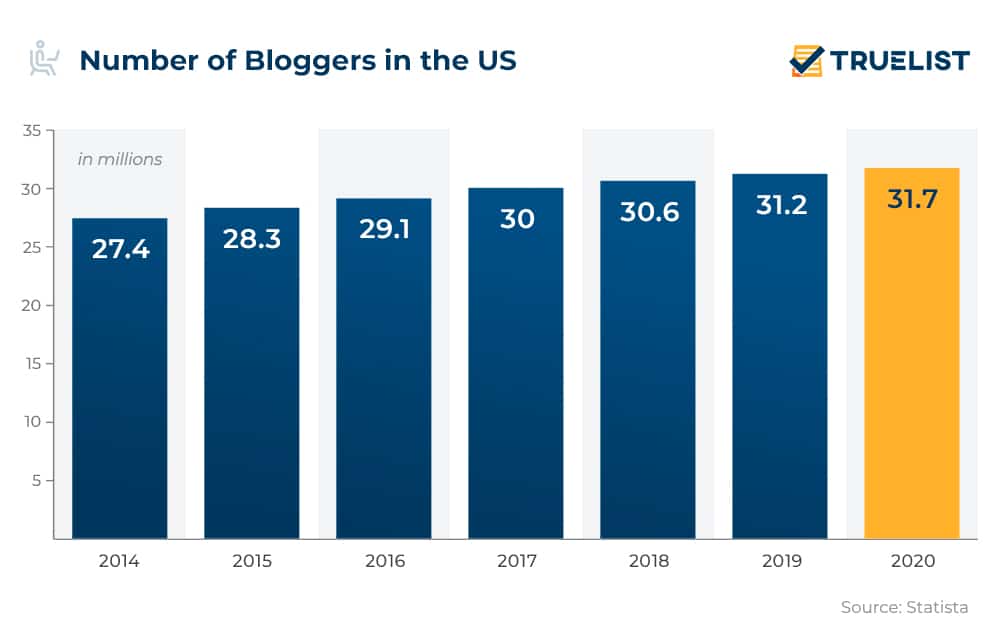
4. It takes an average of 4 hours and 1 minute to write a blog post.
In 2014, writers devoted around two and a half hours to writing a blog post, as blog statistics highlight. A year later, that time increased by 10 minutes, and in 2016, it reached 3 hours and 16 minutes. And after years of continuous increase, the time bloggers now spend on writing a post has leveled to approximately four hours.
(Orbit Media Studios)
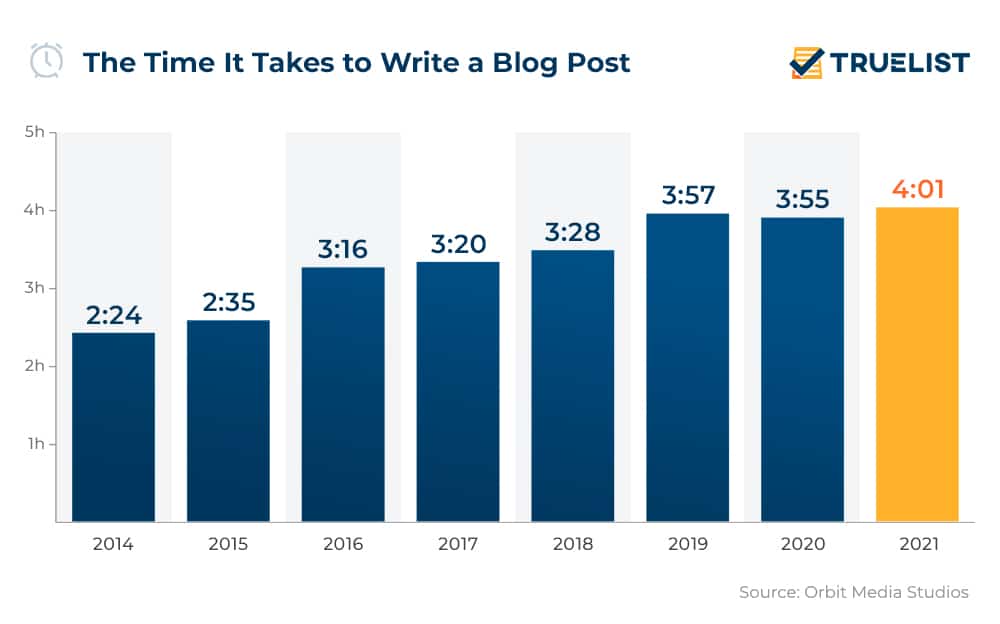
5. A blog post should be between 2,100 and 2,400 words.
In addition to capturing featured snippets, as well as having a solid number of relevant backlinks and the right keywords, the latest blogging trends mention that for SEO purposes and standards, a blog should be up to 2,400 words long or an average of 2,164. Similarly, “how-to” blogs should be between 1,700 to 2,100, and “what is” posts must not be longer than 1,700 words. The minimum recommended blog length post, according to the same research done by HubSpot, is 300 words.
(HubSpot)
6. 77% of internet users read blog posts.
The digital population worldwide is estimated at 4.54 billion people. And more than one source mentions that 77% of these people enjoy reading blogs. So, as Blogging Wizard’s blog readership statistics put it, the fact that about three-fourths of all Internet users read blog posts.
(Blogging Wizard)
7. The US has the highest number of blog posts.
The USA might be the leader in terms of number of bloggers, but research shows that when you divide the number of blog posts by population, it’s possible to calculate which country has the biggest number of blog posts. When blog popularity is in question, the US wins.
(Finances Online)
Blog Demographics
8. 52.43% of bloggers are men and 47.38% are women.
Of the 1030 surveyed bloggers by First Site Guide, 524 are male and 488 are female. In other words, the percentage of male bloggers is higher by only 5.05% making the term gender gap in this niche, almost redundant.
(First Site Guide)
9. More than 50% of bloggers are 21 to 35 years old.
In regards to age, statistics on bloggers show that the majority of bloggers (53.3%) are between the ages of 21 to 35. And even though most people have this notion that blogging is a trait practiced by the younger population, only around 20.2% of bloggers are younger than 20. The third-largest group consists of bloggers between the ages of 36 and 50. Finally, seniors or bloggers over 50 are represented with only 7.1%.
(Finances Online)
10. 37.57% of bloggers have a Bachelor’s degree.
Blog demographics indicate less than 10% of bloggers are high school graduates or have no diploma whatsoever. Research on how educated bloggers are shows that 14.01% have some college but no diploma, 10% have an associate’s degree, while 37.57% and 22.52% have a Bachelor’s and Master’s degree, respectively. And, 5.24% are proud PhD graduates which certainly debunks the myth that bloggers are uneducated people who hide behind their laptops and preach to other people that they know everything about everything.
(First Site Guide)
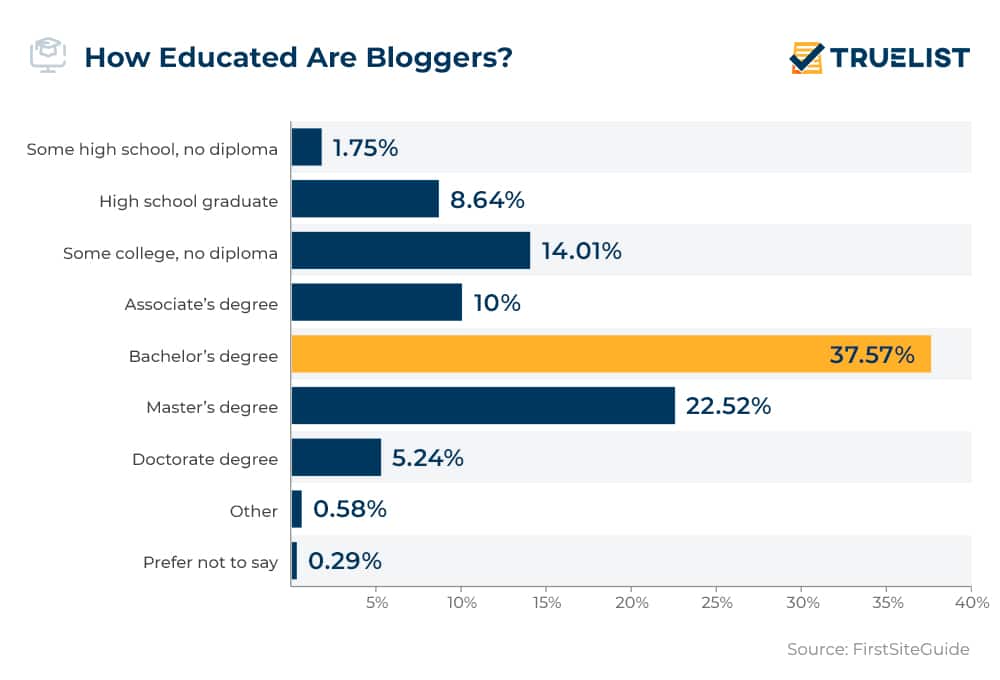
11. The average salary in the blog industry is $79,833 per year.
Blogger statistics reveal the industry is as cruel as any other, and if anyone wishes to succeed and earn a decent amount of money, they have to put in a lot of hard work. Most bloggers rely on publications and PPC ads to make money. In essence, a blogger’s income starts from as low as $34,000 but has the potential to go as high as $362,000.
(Glassdoor)
12. Blog reader demographics show 31 to 40-year-olds read blogs the most.
Research shows that 16.8% of blog readers are 25 to 30 years old and another 29.4% are 31 to 40, or what some would refer to as “late” Millennials. With 23.1%, Generation X (age 41-50) is the second-largest blog readership group, and what is interesting is that even Boomers (14.1%)—who are perhaps the least digital generation—are fans of blogs. Teens and Gen Zers, on the other hand, are not big blog readers.
(Finances Online)
13. Bloggers without children are 33% more likely to become self-employed.
Blog demographics reveal parenting as an obstacle for people who wish to become self-employed as bloggers. Research shows parents are 33% less likely to see blogging as a way to become self-employed or build their own company because they feel a greater sense of burden and responsibility.
(Convert Kit)
Blog Traffic Stats
14. Blogging delivers strong marketing results for 54.2% of bloggers.
Blogging works for nearly 80% of bloggers. Studies mention that blogs deliver good marketing results for a solid 54.2%, while another 24.7% say their hard work pays off to some extent. In contrast, the percentage of writers who believe their blogging efforts to be futile is relatively low at around 21%.
(Orbit Media Studios)
15. A fantastic 90% of bloggers rely on social media to promote their posts.
Social media, according to blogging statistics from Statista, are the best promotion tool and used by almost all bloggers. In addition to social media, SEO is the way to go for 68% of bloggers, and 62% recommend email marketing. Influencer outreach and collaboration is currently used as a promotional tool by 10% of bloggers.
(Statista)
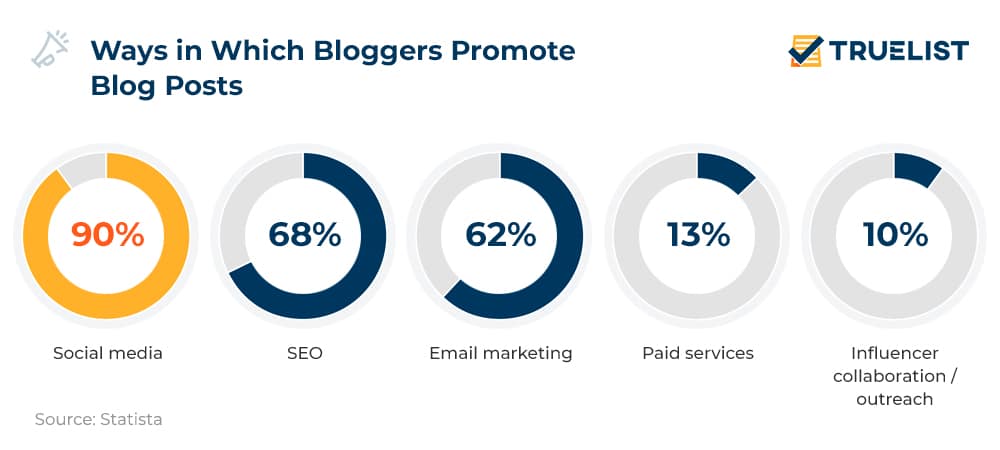
16. Blog traffic stats show a 30% increase once 21 to 54 blog posts are published.
The more blogs you publish, the higher the traffic on your website, or at least this is what the latest facts and figures demonstrate. Driving traffic to their website is a challenge for all marketers and a priority for 54% of them. So what better way to do it than with fresh content?! As these stats highlight, an increase in blog post publishing will most definitely trigger traffic surge.
(Ryan Robinson)
17. Websites with blogs have a 434% better chance of ranking high in search engine results.
Blogging industry statistics are more than clear: content is the gateway to high rankings in SERPs. Interesting and appealing blogs are one of the top three reasons why people decide to follow brands on social media. Let that sink in next time you start working on your SEO strategy along with the 434% higher probability of better ranking.
(TechClient)
18. Blog titles should be between 6 to 13 words long to attract the highest amount of traffic.
There are some interesting secrets and facts about blogging that could really boost your traffic should you decide to acknowledge their efficiency. Namely, if you want your blog title to be appealing and clickable, you must ensure it’s the appropriate size; i.e. no less than 6 and no more than 13 words. In fact, headlines with 6-8 words increase click-through rates by as much as 21%. Also, having a hyphen or colon in the headline will get you a 9% higher CTR. Incorporate these tips next time and see the magic happen.
(OptinMonster)
19. More than 40% of all blog traffic is generated by compounding blog posts.
Recent statistics on blogs reveal compounding posts can collectively generate over one-fourth of all blog traffic. The thing about compounding posts is that they have a huge potential to steadily drive your website’s or blog’s traffic and offer long-term relevancy which is not the case with decaying blog posts. Basically, a compounding blog can drive more traffic than 6 regular blogs combined. Unfortunately, stats show that currently only 1 in 10 blog posts are compounding.
(QuoraCreative)
20. 86% of marketers use blogs to power their content marketing strategy.
Blogs are the shiny gems of marketing, and stats on blogging prove this by revealing that new customers can be acquired by blogging. Moreover, over 55% of marketing professionals claim blogging is the reason they have acquired new customers. Also, nearly nine out of ten marketers produce blogs to help their marketing goals like driving traffic, acquiring new leads, etc.
(Oberlo)
21. 32% of bloggers always check their traffic analytics.
In the world of digital marketing, one cannot know if they are doing something right unless they run tests or traffic analytics. Global blog stats show that only about a third of bloggers always access traffic analytics to check their progress. Less than a third do so usually, while 26% check blog post analytics occasionally. The sad part is that even though the benefits of analytics are widely acknowledged, around 12% rarely access traffic analytics for their online content, and 4% don’t even have access to it.
(Statista)
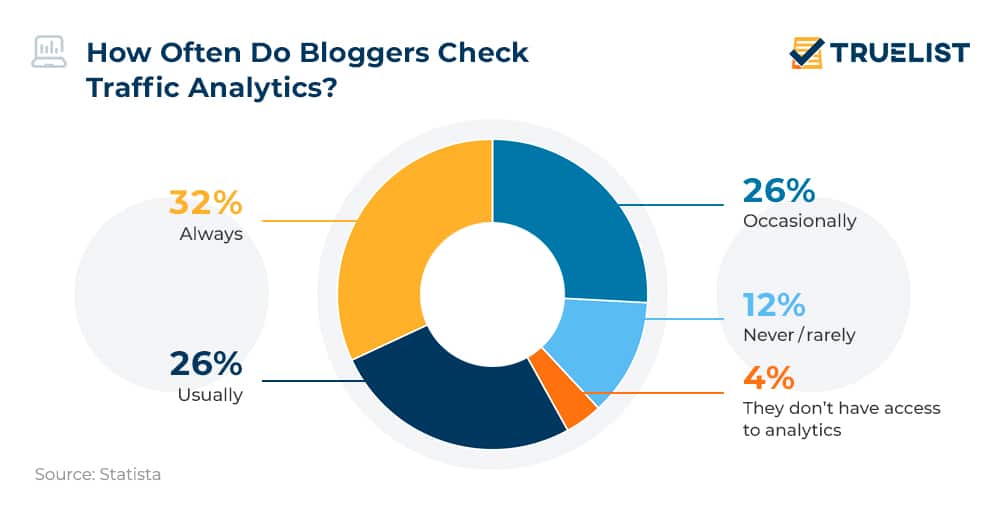
22. Blogging 3 to 4 times a week is optimal for increasing traffic and brand awareness.
Consistency is the key to success. One of the blog facts that every aspiring blogger should know is that publishing 3 to 4 times a week, every week, will most certainly get you the desired traffic. Studies suggest that for updating existing or posting new, larger blogs, the best results can be accomplished if done 4 to 5 times per week. For those aiming to increase brand awareness through their blog posts, publishing one to two small posts and three to four larger ones on a weekly basis is just right.
(HubSpot)
23. Only 3.69% of blogs have more than 500,000 visits per month.
Some 28.06% of blogs have 1,000 or fewer visitors per month, according to blogging statistics. But, although this percentage is good, it is far from satisfactory. Only around 7% of blogs get between 50,000 and 500,000 visits monthly, meaning the percentage of bloggers with six-digit earnings is very low. On the other hand, 20.19% enjoy up to 5,000 views, and 18.45% between 5,000 and 10,000, which points to a huge gap between professional and aspiring bloggers.
(First Site Guide)
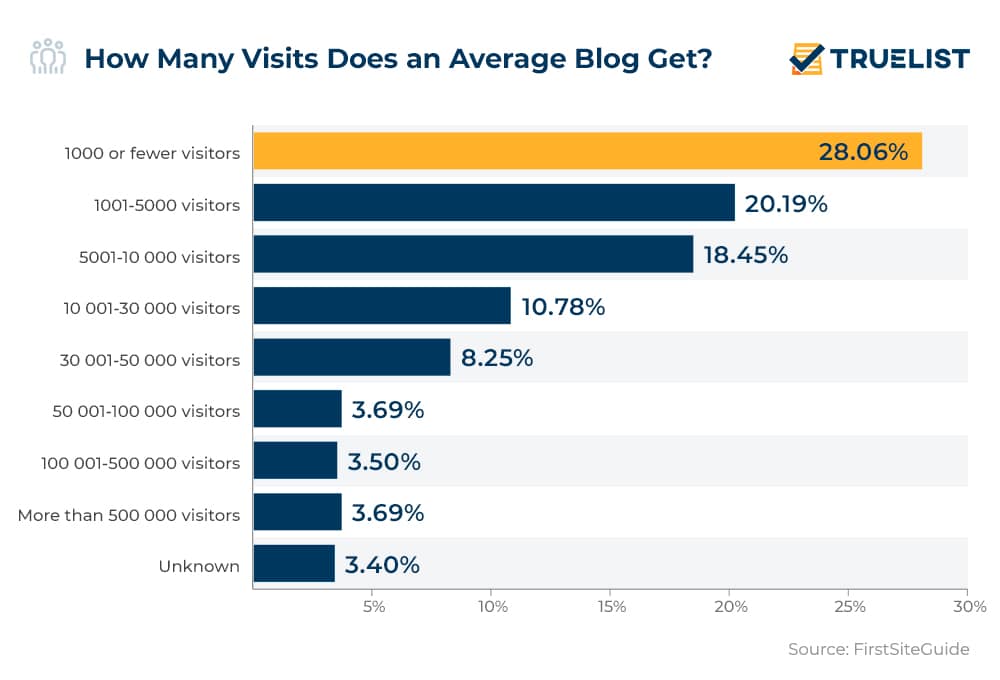
24. Search engines are the top traffic generators for high-performing blogs.
Social media are effective for blog promotion, but the latest blogging trends reveal search engines remain the galvanizers of traffic across all industries. Naturally, Google is king in this endeavor. Popular blogs from a broad spectrum of industries— from pharmaceuticals (62.08%) and automotive (64.89%) to insurance (63.69%) and real estate (56.01%)—get their blog traffic from organic search powered by solid SEO.
(Blogging Wizard)
25. Knowing your target audience can boost your traffic by 488%.
It’s not enough to just produce content for your blog that will be based on extensive keyword research. The key is to know who you’re doing it for. TwinsMommy’s traffic analysis showed a spike by a whopping 488% once the blogger started targeting pregnant, new, and postpartum moms only. Their research also says that adding a new pin graphic noted a 35% traffic increase.
(TwinsMommy)
Guest Blogging Statistics
26. 56% of bloggers write posts for more than one website.
Many marketers still rely on guest posting to promote their brand, and the data that more than 50% of bloggers cooperate with multiple sites proves it. Research also shows that 60% of blogs write up to 5 guest posts a month, and another 3% write as many as 100 for sites other than theirs. Some bloggers (6%) thrive on guest posting and publish almost all of their work as such.
(Medium)
27. Nearly 63% of readers trust blogs with multiple authors more.
A total of 62.96% of readers, according to guest blogging statistics, say they find blogs written by more than one author more trustworthy. And since most people read blogs to learn something new about the latest trends or experiences, it makes sense to prefer content that is written by more than one person and as such, to consider it more credible.
(OptinMonster)
28. A whopping 87% of guest bloggers come up with the post ideas on their own.
The role of a guest blogger is not limited to writing alone and sometimes involves outreach, prospecting, ideation, etc. Blogging statistics mention that 84% of guest writers also do the outreach, and 85% do the prospecting. Furthermore, 81% of guest posters said they were the ones who came up with the idea and the topic for the post. Only 8% of the participants were freelancers, while 37% declared they were staff members.
(ReferralRock)
29. Almost eight out of ten editors believe guest blogging is too promotional.
Even though there are many benefits to guest posting for both the blogger and the website hosting the content, stats on blogging disclose 79% of editors consider such content as exceedingly promotional. Despite popular belief, the main reason why editors choose to post guest content is to attract traffic to their site, offer fresh insights, new opinions, and above all, expert content. Moreover, 94% claim they intend to publish the same number of guest blogs next year or even more.
(OptinMonster)
30. 93% of editors measure guest content success via the number of page views.
There’s no one isolated metric or way to measure the effectiveness of a guest post. For the majority of editors (93%), guest blogging success is measured by looking at the number of page views. Guest blogging industry statistics indicate 75% of editors measure the time readers spend on the site, and 69% use social shares as means to evaluate whether the post has reached its goal.
(Red Website Design)
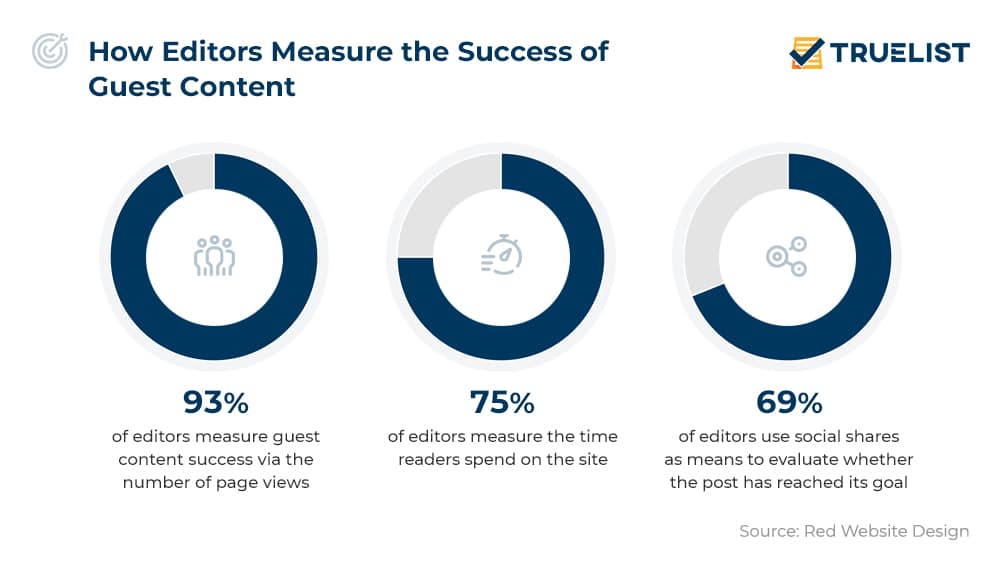
31. Guest posting guarantees an 80% increase in organic and referral traffic.
The main reason for this is that guest posts usually bring 5X more weighty backlinks and thus positively impact ranking. Other studies show 15% of these posts have over 100 visits and 50% have between 50 to 100 visits, which is not much but combined with the organic and referral traffic, it can work wonders. Blog stats also show that guest posting brings a staggering 174% audience extension and brand awareness growth, which is reason enough for any marketer to start guest posting today.
(Medium)
32. Demand for guest topics is highest in December.
Cold December is a blood-thirsty month for fresh guest posts. Editors of popular blogs say the need for fresh content from contributors is highest in December. The second wave of cravings for articles starts in June and ends in August.
(Red Website Design)
Business Blogging Statistics
33. 59.81% of bloggers make money from blogging.
Nearly 60% of bloggers earn a living from blogging, and 49.32% consider blogging a full-time job. When it comes to the methods of earning, some 16.80% make money from selling products or services, 18.74% rely on affiliate marketing, 15.05% use Google search ads, and 10.49% use display ads. Sponsorships and donations provide an income for 9.42% of bloggers. It is important to note that typically bloggers rely on a combination of income sources.
(First Site Guide)
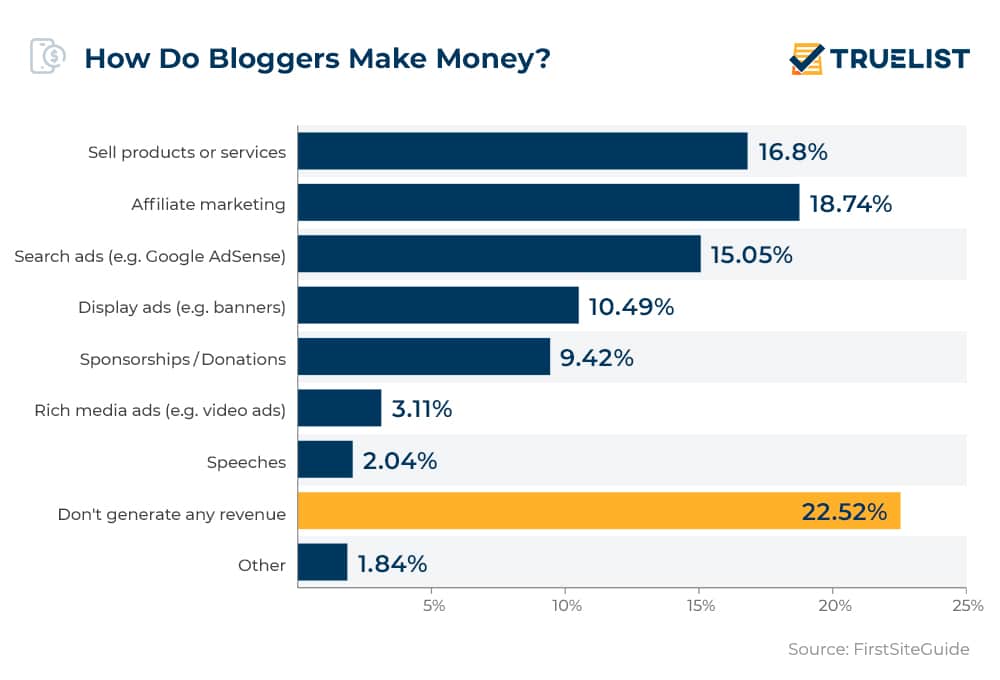
34. 59% of B2B marketers say blogging is good for business.
Facts and stats on blogging mention that, in addition to video and ebooks, blogging is the third most commonly used content marketing strategy. A total of 59% of B2B marketers consider blogs one of the most valuable marketing channels. Why? Because marketing professionals that prioritize blogs typically report 13X higher ROI than the ones that do not consider them effective enough to incorporate in their plans.
(HubSpot)
35. 31% of marketing professionals agree blogs are powerful tools for building brand awareness.
Given the latest business-to-business blogging statistics, it would be unwise for any marketer to underestimate blog posts. Content Marketing Institute’s data show 13% of marketers believe blogs are second-best for nurturing leads, right below email newsletters. The same report also mentions one-third of marketers believe blogs to be strong brand awareness boosters and more effective than social media content (25%) and in-person events (8%).
(Content Marketing Institute)
36. 74% of B2B buyers will share a blog post with their peers.
Sharing is caring, and blogging statistics say 74% of buyers would rather share a blog post with their colleagues than any other type of content. Some 64% of B2B buyers would gladly recommend a recent case study they’ve read, while 62% would suggest an infographic to their peers. White papers and webinars are the favorite sharing content of 61% of B2B buyers.
(Blogging Wizard)
37. Blogs are a trusted source of information for an incredible 81% of US consumers.
And considering half of buyers read up to five pieces of content before they actually contact the sales rep, one of the few known facts about blogging is that blogs give tremendous power to marketers. It is not just that the majority of consumers rely on them for advice, but there is also the fact that when it comes to online services influencing purchase and shaping opinions, at 31.10%, blogs are ranked better than Twitter (8%) and Facebook (30.90%).
(Finances Online)
38. More than 80% of travel planning is done online.
Travel blogs are one of the most popular blogs and as such offer many lucrative opportunities. As travel blog statistics highlight, a fantastic 94% of travel blogs sell advertising, meaning blogs are the gateway to boosting sales in this particular niche. And it’s not just that they are good for business, but they are also a great chance for bloggers to make more money as data reveals that the average travel blogger has a median rate of $200 per sponsored post.
(OptinMonster)
39. Small businesses with blogs generate 126% more leads.
Blogging is successful only if done frequently and regularly, which naturally puts additional pressure on small business owners who struggle to fulfill many tasks within their workday. But as small business statistics on blogs show, if owners really put their heart into this type of content, they will soon experience a fantastic 126% boost in leads which will undoubtedly increase sales and put their small brand on the map.
(DBanzon Design)
Blogging Platforms Statistics
40. 43% of the entire internet is powered by WordPress.
Powering a little over a third of the internet, WordPress is king in the realm of content management systems. Data from Web Technologies Surveys also disclose that 33.1% of the websites do not use any content management systems. The rest rely on Shopify, Joomla, Squarespace, Wix, etc.
(W3Techs)
41. Tumblr had 271 million unique visitors worldwide in February 2022.
Blogging industry statistics show the US microblogging and social networking website experienced a massive drop in the number of visitors from 312.7 million in January 2022 to 271 million in February 2022. The user base of Tumblr has been dropping since 2018 when the company decided to ban porn and adult content, resulting in artists and sex workers moving to other sites that do not have such restrictions on blog posts.
(Statista)
42. WordPress is home to nearly 60 million blogs.
Recent WordPress statistics reveal that on average an incredible 70 million posts a month are being published. WordPress is one of the most widely used free and open-source content management systems, used by millions of bloggers and businesses from all around the world.
(OptinMonster)
43. WordPress users produce around 70 million posts per month.
Given that these 70 million posts generate an additional 77 million comments, plus the fact that brands such as TechCrunch, CNN, Ted, and NBC Sports publish on WordPress, it should come as no surprise that some of the most popular blogs were born of WordPress. WordPress statistics also mention that over 409 million users view more than 20 billion pages each month.
(WordPress)
44. Blogger is the second most popular blogging platform in the world.
Although Blogger is not as famous as Tumblr, thanks to its simplicity and suitability for beginners, it’s ranked second in terms of popularity and used by 1% of blogs that are in the top 1 million sites.
(WPBeginner)
FAQs
How many blogs are there?
There are 600 million blogs hosted on 1.7 billion active websites.
(Oberlo)
How many people read blogs?
A whopping 77% of internet users read blogs.
(OptinMonster)
Who reads blogs?
At 29.4%, people between 31 and 40 are the largest demographic among blog readers, closely followed by those aged 41-50, at 23.1%.
(Finances Online)
What percentage of blogs are successful?
59.81% of bloggers make money from blogging.
(First Site Guide)
How do bloggers make money?
The majority of bloggers make money through affiliate marketing, closely followed by selling products or services, and ads.
(First Site Guide)
How many blog posts are published per day?
Around 4 million blog posts are published on a daily basis.
(Envisage Digital)
Which type of blogs makes the most money?
Conveniently, finance-related blogs are the most profitable. This includes blogs about investments, frugal spending, early-retirement, side-hustles, or anything that has to do with money-handling. Fashion blogs are also one of the most lucrative types of content, along with travel and marketing-related posts.
(Blog Tyrant)
What type of blogs is the most popular?
Personal blogs are the most popular among readers, followed by business and technology, then fashion, food, fitness, and health blogs.
(WPBeginner)
The Final Word
We’ve given you the stats; now it’s on you to make the best of them. While creating interesting content can be challenging, these blogging statistics can help you get your brand’s strategy on track. Use this information to optimize your website; we hope it helps you attract more traffic and increase the number of leads.
Sources: Growth Badger, Oberlo, HubSpot, Glassdoor, Statista, Medium, Finances Online, DBanzon Design, Statista, Orbit Media Studios, Blogging Wizard, First Site Guide, Convert Kit, Ryan Robinson, TechClient, OptinMonster, QuoraCreative, Statista, HubSpot, TwinsMommy, ReferralRock, Red Website Design, HubSpot, Content Marketing Institute, W3Techs, Statista, WordPress, WPBeginner, Envisage Digital, Blog Tyrant, WPBeginner

